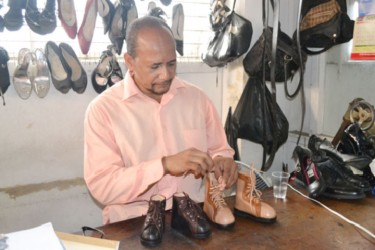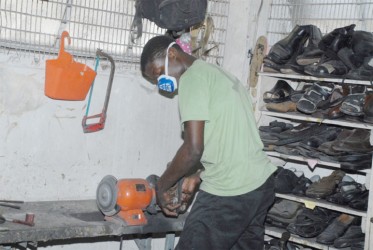Michael Carrington believes that the current boom in the country’s shoe repair sector is a result of what he says is the aggressive “dumping” of inferior products on the local market.
People, he says, buy what they can afford and not everyone is immediately aware of the lack of long-term wisdom in purchasing what is commonly described on the streets as ‘cheap and sweet’.
The subsequent price in repair costs is paid mostly by parents of school-age children. Rendering inferior footwear

that has come apart under the relentless pounding of active children and poor roads has become the bread and butter of shoemakers. The trade is busiest just before the start of the school year. Not every parent can afford to change their children’s shoes annually.
The market has become wise to the quality of shoes generally available here. In cases where the sole is attached to the rest of the shoe by paste rather than by stitching you have the stitching done by a cobbler before you actually wear the shoes. Sometimes, firms that must provide footwear for their employees provide shoe-making establishments with lucrative contracts to re-enforce several pairs of new shoes. It is a precaution that adds to the cost of the shoe without necessarily providing a solution.
Carrington has come to understand the ‘ins and outs’ of the industry. He is the proprietor of Ford Shoe Repairs, persisting in the pursuit because he remains convinced that it is still a viable one.
For several years he had manufactured his own brand, Tuff Shoes, designed – or at least so he felt – to withstand the rigours of the local terrain. That, however, failed to alter consumer taste for imported brands and in 1997 he was compelled to fall back on rendering and repairing shoes. It was the dumping of cheap shoes here, he believes, that ultimately defeated his manufacturing ambitions.
Carrington estimates that Guyana imports approximately three million pairs of shoes annually. He estimates that most people may purchase up to five pairs of shoes annually. “The repairs industry is sustained primarily by the quality of shoes and bags that we import. Once we go on like this there will always be work [for cobblers],” he says.
Carrington says that most of Guyana’s shoe imports arrive in the country via Panama. Often, he says, the shoes lie in storage in sweltering hot containers in Panamanian ports. That is where the damage is done.
As the repair sector grows, the challenges increase. Shoe rendering and repairs is a taught skill and Carrington says that his main problem is finding dedicated workers. He persists because it is “good business”. There are several reasons why shoes are repaired or rendered. Setting aside the lack of confidence in the integrity of new pairs of shoes, there are those that require re-soling, re-heeling or, for one reason or another, stitching or tacking.

He talks about the changes that have occurred in the shoe-making industry. Current production practices favour cheap imitations that sell well in poor countries. These days, there is far less attention to manufacturing detail. He points out, for example, that whereas in the past up to three quarters of an inch of material was used to fit inner soles to shoes, contemporary manufacturers use a quarter of an inch of material and cardboard rather than leather. The thinness of the cushion is bad for both the shoe and the foot.
The cost of stitching a pair of shoes could range from $600 to $1,500; re-soling costs may range from $2,000 to $6,500, while re-heeling usually costs around $600. The folly of cheap shoe imports is evident in the high repair costs.
Nor should the damage to shoes be blamed entirely on bad roads. Often, he says, the heels of ladies shoes imported into Guyana are hollow so that there is nothing there to hold the tips attached to the ends of the heels to protect them. These days, Carrington says, repairs to ladies’ shoes sometimes involve removing the entire heels and re-enforcing them.
Carrington returns to the theme of finding workers. These days, most forms of urban employment give way to the lure of the interior. Some workers train poorly and demand high salaries. In training, his workers earn $15,000 per fortnight. The training can last for up to three months but can sometimes extend for up to a year. After that, the new cobblers can earn between $70,000 and $100,000 per month. He points out that there used to be a time when the trade was taught in some schools. These days, it has disappeared. There used to be a time too when parents would have their boys assigned to shoemakers as apprentices. That too is no longer the case.
High demand and a scarcity of skills have compelled Carrington to contemplate a training programme of his own. He believes, however, that this time around apprentices should pay a fee to learn the trade. That, he believes, will provide the requisite motivation for them to apply themselves.
He is confident that it will motivate apprentices to remain in the programme. He is even hoping that at the end of the programme, he will sub-contract out some of his work to those who have potential; therefore, there will be work available. He said he is unable to take all of the jobs being offered.
His current machinery is much the same as has long been used in the industry; sole stitchers, buffing machines, for sanding and polishing, stretchers and machines for stitching bags and belts.
Accessing high quality material for the industry has been a traditional problem. Material is still not imported so the industry relies on locally produced vegetable tanned leather. Once it was produced from the bark of mangroves. These days, environmental restrictions preclude the harvesting of mangrove bark for the purpose.
A single cow’s hide can cost between $4,000 and $6,000. A single hide can sole about twenty pairs of shoes. Carrington is unsure about the number of tanneries in Guyana but says that he makes his purchases from Roy Cummings who sells on the Merriman Mall.
Carrington’s shoe-making skills are well-known. His shoes are marketed across Guyana, in the Caribbean and to a lesser extent in Europe and North America. Sometimes, holidaying Guyanese bring their shoes to him for repairs. Some of his customers have been repairing the same shoes for more than 15 years.
The manufacture and repairs of shoes is a skill he has been practicing for more than 30 years. He happened upon it by chance in 1980 after responding to an invitation from a friend, Charles Nobrega to his Fifth Street, Alberttown shop to “learn a trade”. Three months later he opened his own establishment in Newtown, Kitty. By 1983 he moved his business to New Amsterdam, close to the Guyana Leather Craft Limited Tannery. The restrictions on imports that obtained during the 1970s helped his business. Local stores including JP Santos, Fogarty’s and Guyana Stores began stocking his shoes.
During the 1980s, Carrington developed a business relationship with the well-known Tiger Bay shoemaker Gerald Foreman whose Foreman’s Electrical Shoeshop had developed a considerable reputation. He purchased materials from the now deceased businessman and during his visits to Georgetown the Tiger Bay establishment became one of his compulsory stops.
In 1989, during one of his trips Foreman announced that he intended to close the shop. Carrington immediately struck a deal to rent the shop for $5,000 per month. He moved his business – Tuff Shoes -to Tiger Bay. There he manufactured a range of shoes including copies of the famous Clarks brand, moccasins and leather sandals. His shop also produced bags, leather belts and heavy duty belts for factories and for GPL field workers.
1997 saw a sharp drop in business which he attributes to the wholesale dumping of cheap shoes on the local market. Patronage fell away rapidly. Eventually, the famous Tiger Bay establishment closed.
In 2007, he had opened a branch in the General Post Office building. That location still exists though the opening and closing hours are restrictive. Last year he established another facility at Vreed-en-Hoop, prohibitive rental costs militating against another branch in Georgetown. Still plagued by the difficulties associated with finding workers he now works alone at his new establishment.
Carrington’s ambition to expand is tempered by his consummate understanding of the vagaries of the trade. Modest businesses like his still face difficulties accessing financing while the current proliferation of imports places limits on local demand for his home-made shoes.





